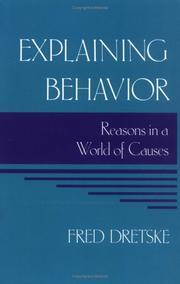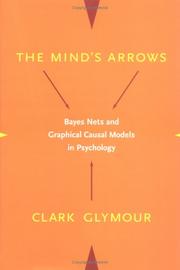| Listing 1 - 3 of 3 |
Sort by
|

ISBN: 0262271966 0585020523 0262540614 0262040948 9780585020525 9780262271967 9780262040945 9780262540612 Year: 1988 Publisher: Cambridge, Mass. : MIT Press,
Abstract | Keywords | Export | Availability | Bookmark
 Loading...
Loading...Choose an application
- Reference Manager
- EndNote
- RefWorks (Direct export to RefWorks)
Psychology --- Human behavior --- Causation --- Social Sciences --- Philosophy --- Causality --- Cause and effect --- Effect and cause --- Final cause --- Action, Human --- Behavior, Human --- Ethology --- Human action --- Human beings --- Behavior --- Human behavior. --- Causation. --- Explanation. --- Philosophy. --- Human biology --- Physical anthropology --- Social sciences --- Psychology, Comparative --- Beginning --- God --- Metaphysics --- Necessity (Philosophy) --- Teleology --- Psychologie --- Comportement humain --- Causalité --- Philosophie --- Psychology - Philosophy.

ISBN: 0691020450 069107318X 9780691020457 Year: 1987 Publisher: Princeton (N.J.) Princeton university press
Abstract | Keywords | Export | Availability | Bookmark
 Loading...
Loading...Choose an application
- Reference Manager
- EndNote
- RefWorks (Direct export to RefWorks)
Science --- Causation --- Realism --- Positivism --- Philosophy --- #GROL:SEMI-167 --- #SBIB:316.23H1 --- 316.75 <043> --- Kennissociologie --- Kennissociologie. Ideologie--Dissertaties --- 316.75 <043> Kennissociologie. Ideologie--Dissertaties --- Philosophy of science --- Normal science --- Empiricism --- Universals (Philosophy) --- Conceptualism --- Dualism --- Idealism --- Materialism --- Nominalism --- Rationalism --- Humanity, Religion of --- Religion of humanity --- Agnosticism --- Deism --- Philosophy, Modern --- Religion --- Religions --- Causality --- Cause and effect --- Effect and cause --- Final cause --- Beginning --- God --- Metaphysics --- Necessity (Philosophy) --- Teleology --- Science - Philosophy

ISBN: 0262072203 0262273969 058547544X 9780262273961 9780262318730 0262318733 9780262072205 9780585475448 Year: 2001 Publisher: Cambridge, Mass. MIT Press
Abstract | Keywords | Export | Availability | Bookmark
 Loading...
Loading...Choose an application
- Reference Manager
- EndNote
- RefWorks (Direct export to RefWorks)
In recent years, small groups of statisticians, computer scientists, and philosophers have developed an account of how partial causal knowledge can be used to compute the effect of actions and how causal relations can be learned, at least by computers. The representations used in the emerging theory are causal Bayes nets or graphical causal models. In his new book, Clark Glymour provides an informal introduction to the basic assumptions, algorithms, and techniques of causal Bayes nets and graphical causal models in the context of psychological examples. He demonstrates their potential as a powerful tool for guiding experimental inquiry and for interpreting results in developmental psychology, cognitive neuropsychology, psychometrics, social psychology, and studies of adult judgment. Using Bayes net techniques, Glymour suggests novel experiments to distinguish among theories of human causal learning and reanalyzes various experimental results that have been interpreted or misinterpreted - without the benefit of Bayes nets and graphical causal models. The capstone illustration is an analysis of the methods used in Herrnstein and Murray's book The Bell Curve ; Glymour argues that new, more reliable methods of data analysis, based on Bayes nets representations, would lead to very different conclusions from those advocated by Herrnstein and Murray.
Philosophical anthropology --- Artificial intelligence. Robotics. Simulation. Graphics --- Psychology --- Prediction theory. --- Causation. --- Causality. --- Prediction theory --- Causation --- Social Sciences --- Methodology. --- methods. --- Methodology --- Causality --- Cause and effect --- Effect and cause --- Final cause --- Forecasting theory --- Enabling Factors --- Multifactorial Causality --- Multiple Causation --- Predisposing Factors --- Reinforcing Factors --- Causalities --- Causalities, Multifactorial --- Causality, Multifactorial --- Causation, Multiple --- Causations --- Causations, Multiple --- Enabling Factor --- Factor, Enabling --- Factor, Predisposing --- Factor, Reinforcing --- Factors, Enabling --- Factors, Predisposing --- Factors, Reinforcing --- Multifactorial Causalities --- Multiple Causations --- Predisposing Factor --- Reinforcing Factor --- Beginning --- God --- Metaphysics --- Philosophy --- Necessity (Philosophy) --- Teleology --- Stochastic processes --- COGNITIVE SCIENCES/General --- COGNITIVE SCIENCES/Psychology/Cognitive Psychology
| Listing 1 - 3 of 3 |
Sort by
|

 Search
Search Feedback
Feedback About
About Help
Help News
News